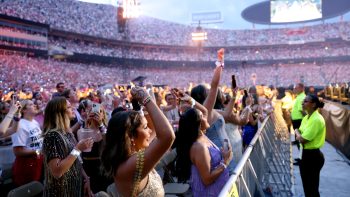
How one company is tackling the tricky — and expensive — task of recycling clothing
How one company is tackling the tricky — and expensive — task of recycling clothing


From the seat of a forklift, Chanalisa Sera moves hundreds of boxes of clothes within a warehouse in Los Angeles. Her job gives old clothes new life.
“I didn’t know all this stuff went to the landfill,” she said.
Sera works for Homeboy Industries, which rehabilitates and employs formerly incarcerated and gang-affiliated people. She and her coworkers are sorting, selling, sewing, repairing and repurposing clothes.
“I learned how to input weights and data entry into the computers. I learned different fibers like you can feel it and you can be like okay, this is this, this is that,” she said.

Clothing companies bring their unsold or returned stock to the warehouse, where Sera repairs or recycles it so it can be resold.
“Corporations are more sensitive to the idea now that there is no ‘away’ when you throw something away. It’s actually going somewhere,” said the CEO of Homeboy’s apparel business, Chris Zwicke.
And there’s plenty of material to work with. U.S. consumers buy five times more clothing than we did 40 years ago and toss about 81 pounds of clothes per person each year.
“It’s a gap in the market that we’ve seen, and that we’re filling with our workforce development mission,” Zwicke said.
Most clothing can be recycled, but it’s difficult to do it affordably. Even a cotton shirt might have labels, embroidery, buttons, or zippers, and recycling it requires manual labor from a skilled workforce. It’s a lot more expensive than throwing it away, which is partly why less than 15% of discarded clothes get recycled.
One clothing company that’s willing to try is GUESS, which invests in Homeboy Industries.
“Initially we started the pilot with store returns, damages [and] irregular product,” said Nicolai Marciano, direct of brand partnerships for GUESS.
Then, in April 2022, GUESS started letting customers bring their own clothes back into the store to get recycled or repurposed.
“Since the launch of our pilot program in December 2021, Homeboy has received over 200,000 pounds of garments to avoid ending up in landfills,” he said.
Patagonia, Hanes, Levi’s and other companies also have programs dedicated to curbing textile waste.
And California wants it to catch on even more. Lawmakers introduced a bill this year called the Responsible Textile Recovery Act of 2023, which would require textile producers to figure out how to collect and recycle reusable clothes and textiles.
There’s a lot happening in the world. Through it all, Marketplace is here for you.
You rely on Marketplace to break down the world’s events and tell you how it affects you in a fact-based, approachable way. We rely on your financial support to keep making that possible.
Your donation today powers the independent journalism that you rely on. For just $5/month, you can help sustain Marketplace so we can keep reporting on the things that matter to you.

















